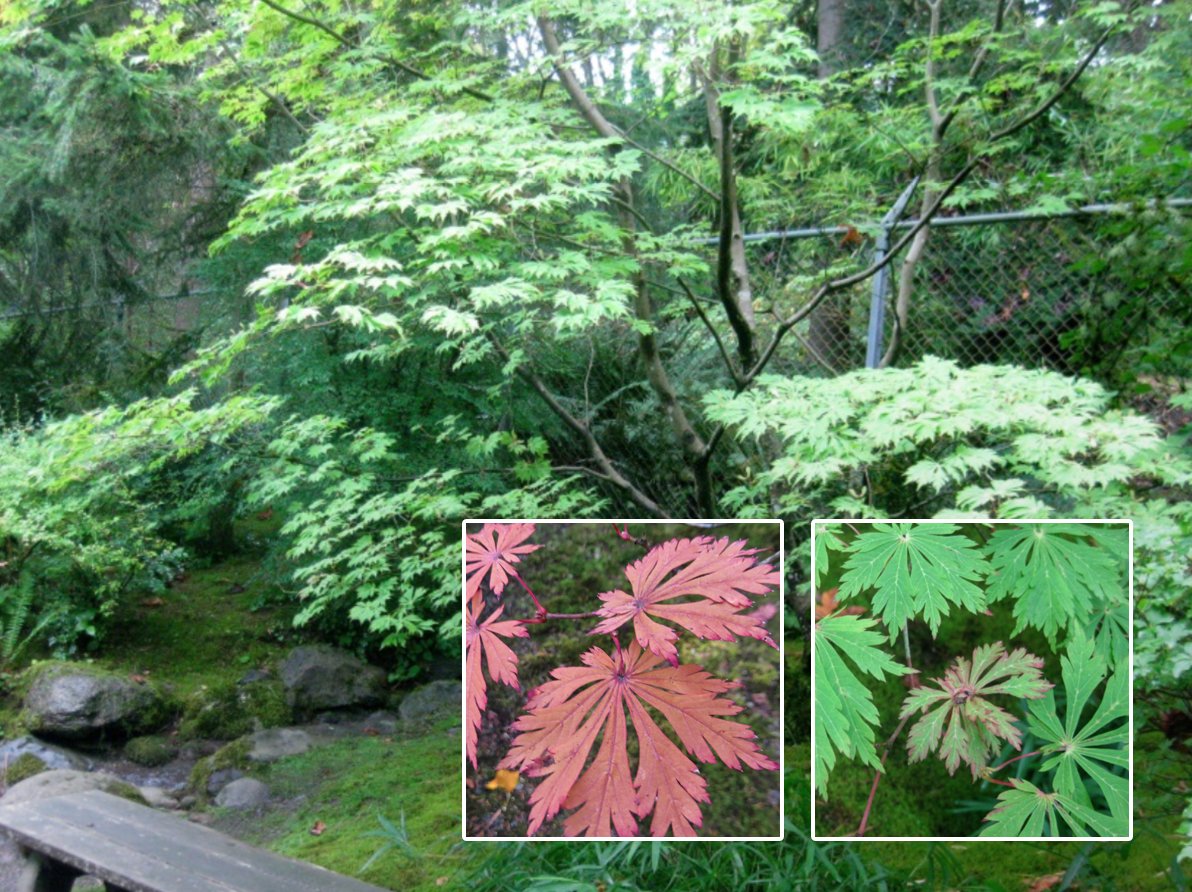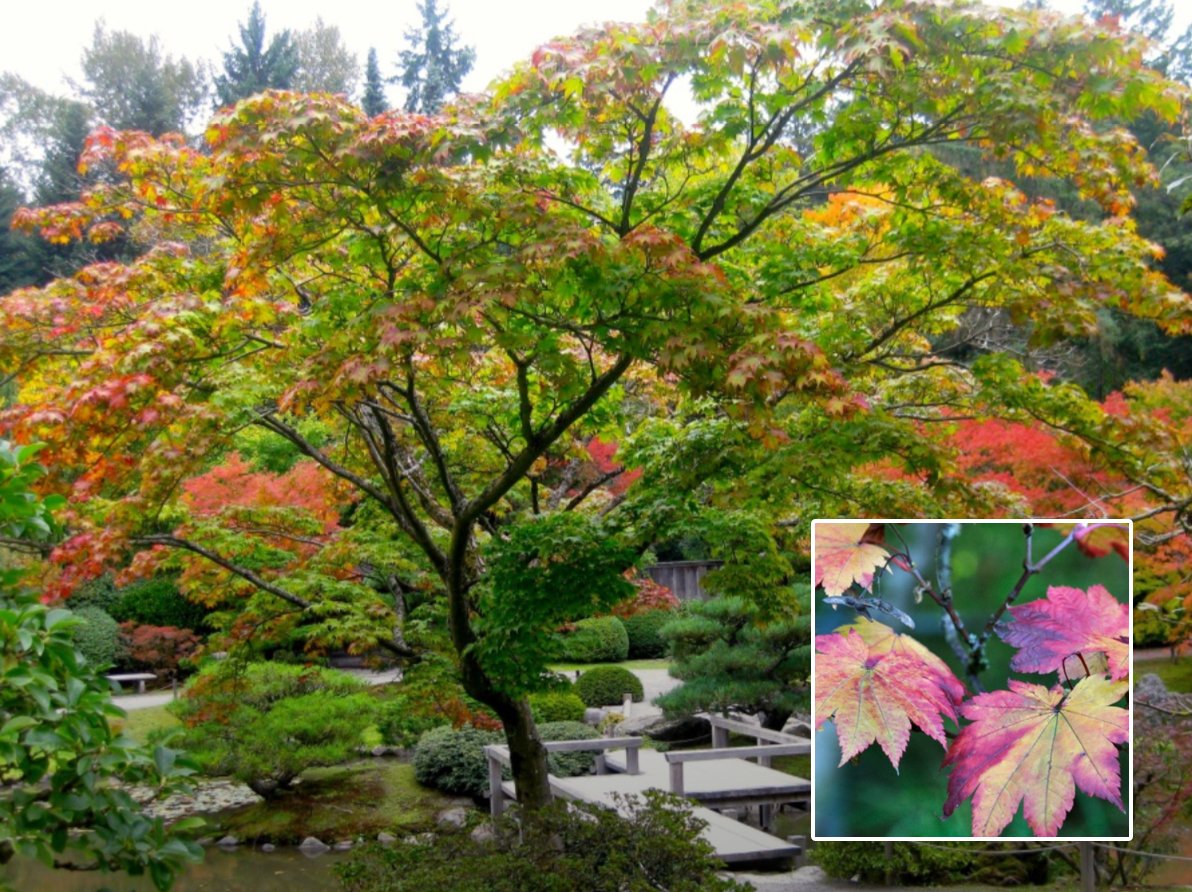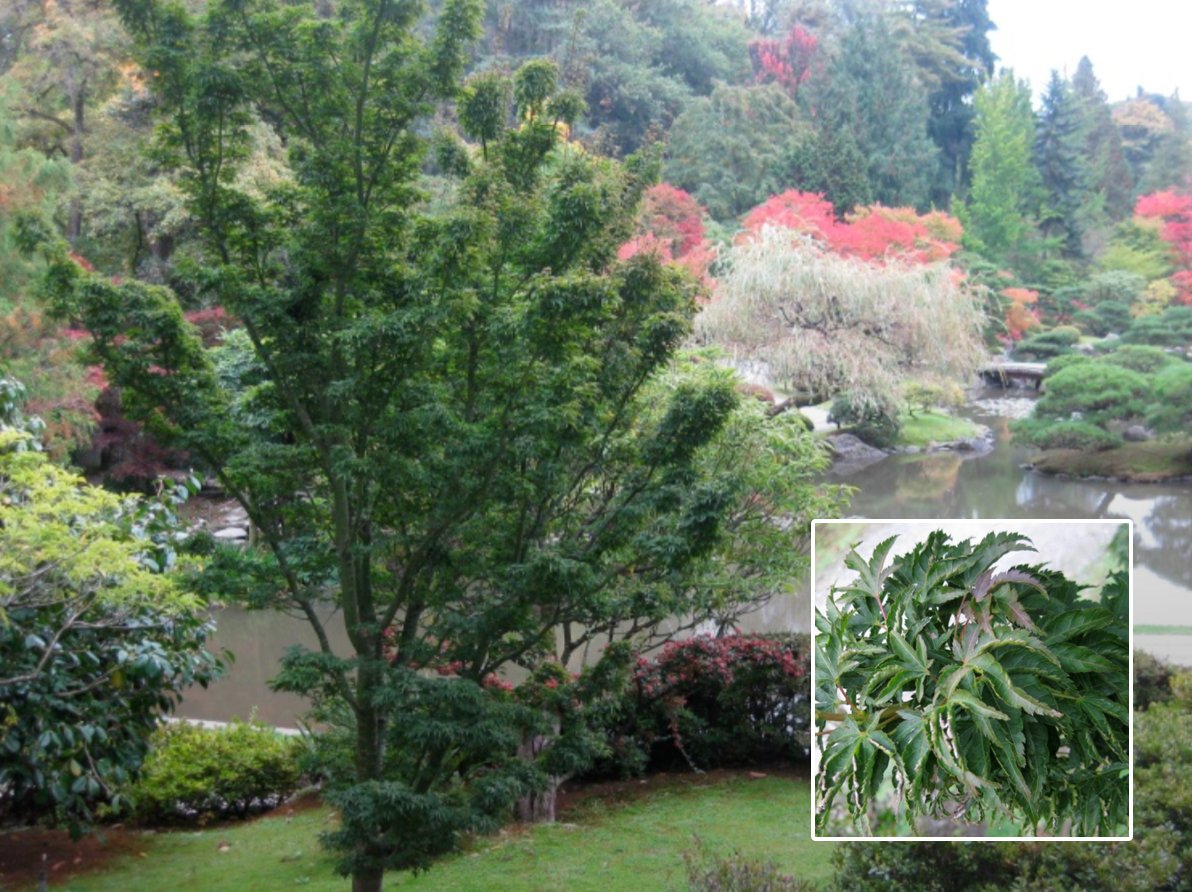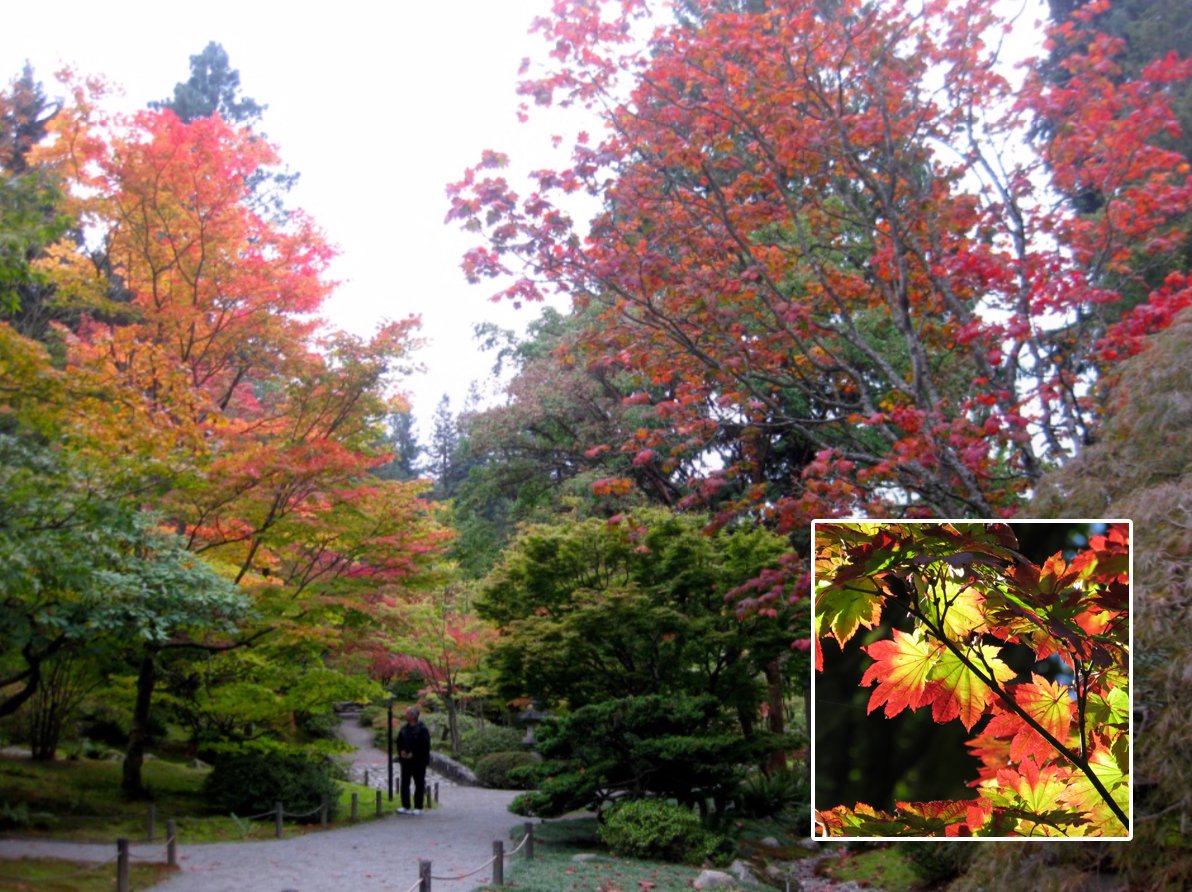Maple Collection
Plant Area Map — Maple Collection
About Maples
Acer・Maple・カエデ・楓 / Kaede • Maples grow across northern continents, including northern Africa and Asia. All have samaras: winged nuts containing a single seed. Maple wood is pale without resin. The leaves are generally in a palmate form with veins coming from a central point. There are four pigments in leaves: Chlorophyll(green), Carotenoids(yellow, orange, red and purple colors), Tannins(brown), and Anthocyanin(blue, red, or purple). Chlorophyll creates green color in the spring and summer. In the fall when Chlorophyll fades, Carotenoids and Tannins rise to dominance and the leaves turn yellow, orange, and brown. The maple leaves which contain Anthocyanin change the color into red, purple, and pink. The Seattle Japanese Garden has many kinds of maples. In the fall, these maples change color to red, orange, yellow, purple and pink, and showcase the stunning beauty of autumn foliage.
Japanese lace leaf maple Acer palmatum var. dissectum ‘Atropurpureum’ aka: Acer palmatum ‘Dissectum’
Grows in areas B, C & Y.
The ‘Atropurpureum’ in areas B and C are located across the main path from one another. This strongly cascading tree has long, drooping branchlets that form a dome-shaped plant at maturity. It reaches up to 12’ and at least as wide. The leaves have 7 or 9 lobes and each lobe separates entirely to the petiole attachment. It is the most familiar form of the Japanese maple and occurs naturally with red or green foliage. Properly cared for 75 to 100-year-old specimen plants possess a magnificent stateliness.
Japanese lace leaf maple
Burgundy lace Japanese maple Acer palmatum ‘Burgundy Lace’
Two grow in area B
This spreading tree grows up to 18’ high and wide. The spring and early summer coloration is the typical burgundy red, but as the season progresses it turns bronzy or greenish. In autumn, it turns a deep red. The leaves are deeply divided into seven ribbon- like lobes that are separated virtually to the leaf base. Lobes are sharply toothed along the entire margin. The ‘Burgundy Lace’ received the Royal Horticultural Society’s Award of Garden Merit, 1977. This splendid cultivar was originated in the US in the 1950s.
burgundy lace Japanese maple
Fern leaf Fullmoon maple Acer japonicum ‘Aconitifolium’
Area ZZW.
The ‘Aconitifolium’ maple is a small, slow growing, upright tree that can grow to 16’ tall by 16’ wide. It has red flowers in the spring along with green leaves. The leaves are large, 4 – 6,” and resemble those of Aconitum, the monkshood genus. The leaves have 9 to 11 broadly opening lobes that narrow down to the point of intersection at the base. ‘Aconitifolium’ was cultivated in 1888 in England. It is grown for its pleasing shape, spring flowers and green leaves, and for its intense fall colors of orange, carmine-red and purple. In Japanese, ‘Aconitifulium’ is Mai-Kujaku, meaning “dancing peacock.” The tree in our garden was planted in 1995 and was donated by Kathleen Smith.
fern leaf Fullmoon maple
Acer palmatum ‘Shigitatsu sawa’ aka Acer palmatum ‘Reticulatum’
One is located in area ZZW.
This maple grows upright to 15 to 20 feet tall and wide. The growth has an open elegant layering with “reticulated” leaves like stained glass windows. The leaves are 7- to-9 lobed, toothed, slightly cupped & tapering to a sharp point &“reticulated” – light yellow-green with prominent darker veins. When the leaves darken in mid- summer, the reticulation is less prominent. The meaning of this cultivar name is “snipes, quaking, fly up from the swamp.” Shigitatsu Sawa is the name of a place in Sagami-Oiso that a poet named about 200 years ago. The following is from an old poetry book: “In the evening, in Fall, at Shigitatsu Sawa, even a person whose heart is vacant, feels sad.” The fall color is bright red or rich red-green.
Acer palmatum ‘Shigitatsu sawa’ aka Acer palmatum ‘Reticulatum’
Vine maple Acer circinatum
There are many Acer circinatum in areas F,O,V,Y & ZZE
The multi-stemmed shrub or tree reaches a mature height of about 20-25 feet.. The bark is smooth green to reddish gray, and the twigs are reddish. The 4” green round shaped leaves have 7-11 broad lobes. They are not deeply cut and have toothed margins. The leaf bases are heart shaped. The flowers are purple-red in clusters and the samaras deep red at maturity, with an almost 180 degree spread. The leaves are orange- red in the fall. The vine maple is native to Pacific Northwest, a common understory tree in western coniferous forests, and a favorite food of deer. The young limbs are flexible, often used for snowshoes frames and drum hoops.
vine maple
Acer palmatum ‘Osakazuki akame’
One is located in area W, one in X & one in Y.
The growth is upright and round-topped, 20’ tall and very broadly spreading to 30 feet wide. The leaves are 7- lobed, firm-textured, toothed, and broad with a narrow tip. They are a rich green in spring & summer. The base of the leaf forms a cup-like shape, and the meaning of ‘osakazuki’ is “saki-cup- like-leaf.” The meaning of ‘akame’ is “red shoots.” This is a recent introduction from New Zealand, closely related to the very old Japanese cultivar ‘Osakazuki,’ which has been listed in Japan since the mid-1800. The main differences are ‘Osakazuki akame’ has a smaller leaf, and the growth habit is broader than tall when fully grown. The fall color is an intense crimson, almost like that of the Burning Bush, Euonymus alatus.
Acer palmatum ‘Osakazuki akame’
Nikko maple Acer nikoense aka Acer maximowiczianum
One grows in area ZZW, near the beginning of Area U and the path from the Tea House
Acer nikoense can grow to 30’ to 45’ tall. It has dark gray to blackish bark. The trifoliate leaves are 4” long by 2” wide. They turn a pinkish-red color in late autumn and the three lobes separate as they fall. The Nikko maple was first introduced to cultivation in1881 in England after being discovered by Charles Maries in the forests of Hokkaido. It was grown for its medicinal uses including treatment for liver disease and acute and chronic eye disease at the Buddhist temple Tsubosaka Dera over 400 years ago. It is again being investigated for its use in traditional medicine. Nikko maple is known as megusuri-no-ki, meaning “eyes medicine.”
Nikko maple
Acer palmatum ‘Samidare’
One is in area Q, west of the zigzag bridge
Growth is upright and round-topped, about 15 –18 feet tall and wide. The leaves are 5 to7 lobed, large, of heavy texture, almost smooth, and blunt- tipped. They emerge almost pink, quickly turning a blend of green with light reddish margins. The meaning of ‘Samidare’ is “early summer rain” & refers to the long June rains in Japan. The fall color has varying blends of gold & crimson or purple; many have gold-green centers with red-purple lobes. This subtlety is unusual in fall color.
Acer palmatum ‘Samidare’
Lion's mane maple Acer palmatum 'Shishigashira'
One is located in area N
This slow, upright grower forms a multi stem shrub or small tree, 10 – 15 feet high with a spread of 5 to 7 feet. The bright green crinkled leaves grow in dense clusters along the branches. They have 5-7 lobes, and are 2” long. The flowers are reddish-purple. The ‘Shishigashira’ name comes from the costume worn during the lion's dance to exorcise evil spirits. Sometime this tree is labeled 'Ribesifolium' referring to the resemblance of the leaves to those of Ribes alpinum. One of the last maples to color in the fall, the leaves turn scarlet or golden yellow burnished with red.
Lion's Mane Maple Acer palmatum 'Shishigashira'
Striped-bark maple aka: red snake-bark maple Acer capillipes
Two grow in area M
The capillipes maple grows up to 45’ with a spreading crown of long, slender, and arching branches. It is a water-loving species. The leaves are conspicuously veined, and have a dominant broad triangular center lobe with a narrow, pointed tip and small, sometimes inconspicuous, shallow side lobes. Endemic to Japan, the capillipes maple is concentrated in a fairly small area of central Honshu, in the mountain areas around Tokyo. Capillipes is derived from the Latin capillus for thread, or hair-- referring to the fine branches of the tree, and to the stalk of the samaras, which are as thin as hair. The attractive bark is green to gray with light, lengthwise stripes with regular narrow vertical lenticels. It turns gray brown with darker stripes and becomes slightly fissured as it ages. The leaves turn to bright yellow, orange or red In Autumn.
striped-bark maple aka: red snake-bark maple
Ōmato Japanese maple Acer palmatum ‘Ōmato’
One is located in Area K, on the island between the paths
‘Ōmato’ is a straight growing, round-headed tree with outstanding limb structure. It can grow to 20’ to 25’ tall in over 25 years. It has large leaves with 5 to 7 gradually tapering lobes. Spring foliage has a tint of orange-red but the large leaves turn rich green in the summer, turning to brilliant tones of red in the fall. ‘Ōmato’ originated in Japan in 1930. It is grown for its large colorful leaves, red samaras in the fall, and its elegant vase shape growth. The meaning of Ōmato is “big target.”
Ōmato Japanese Maple
Koto-no-ito Japanese maple Acer palmatum 'Koto-no-ito'
One grows in area A, one in F & one in L
The growth habit of 'Koto-no-ito' is upright, with a mature size of about 15' tall by 10' wide.. It is a Linearilobum type of maple with 5 or 7 long, narrow lobes. These very narrow strap-like leaves inspired the name 'Koto-no-ito’, which means “harp strings.” It has been described as the “dancing monkey tree” for the way the extremely narrow lobes dance in the wind. ‘Koto-no-ito’ was introduced and named by Koichiro Wada in Japan in 1938. The new leaves unfold with crimson tones but soon turn green. Fall color begins as a wonderful yellow, moving towards gold and finishing blended with orange.
Koto-no-Ito Japanese maple
Acer palmatum ‘Tsuma gaki’
There is one in area D
The growth is upright and round-shaped to 10 feet tall and wide The 5 (sometimes7) lobed leaves emerge drooping from the petioles, and are soft yellow-green with purple-red tips. The color in summer is deep green. The new leaves are drooping and look like many ‘leaf-hands’ with brightly painted nails. The meaning of ‘Tsuma gaki’ is “nails edge.” The tree has excellent fall color of radiant crimsons and reds.
Acer palmatum ‘Tsuma gaki’
Paper bark maple Acer griseum
One in area C
This upright, rounded-top tree has dramatic, conspicuous reddish brown bark that peels off like paper, showing the lighter cinnamon color of the inner bark, with a mature size of about 20-30' tall by 15-20' wide. The tri-foliate leaves are opposite, dark green above and glaucous blue-green (gray) below. The word 'griseum' refers to the gray underside of the leaves. The samaras have 90-degree wings. The fall color is dark red to yellow and the three lobes separate as they fall in autumn The paperbark maple is native to Central China and the genus first appeared in the Permian, 250 million year ago. It was introduced to Europe in 1901 by Ernst Henry Wilson. The Japanese Garden acquired our specimen in 1964.
paper bark maple Acer griseum
Japanese Fullmoon maple Acer japonicum ‘Vitifolium’
One grows in area C and one in area Z.
They grow across from each other on the main path. This cultivar is large for the species. It is upright and becomes broad and round-topped with age, reaching at least 30’. The leaves are deep green and of good texture with 8 – 15” long stiff petioles. There are 9 or 11 lobes, and each lobe is separated almost halfway to the leaf base. The red flower trusses are quite distinctive. The fall colors are magnificent. The golds predominate at first, with strong tones of crimson and scarlet, changing to a vivid scarlet before the leaves drop. As the name implies, the large leaves resemble the grape genus Vitis.
Japanese Fullmoon Maple Acer japonicum ‘Vitifolium’
Japanese dwarf leaf maple Acer palmatum 'Yatsubusa'
One in area C
The ‘Yatsubusa’ is a tight branching, rounded compact shaped tree. The leaves are small, compact, and tightly layered, with 5-7 lobes. The word “yatsubusa” means “small,” or “dwarf.” It is the smallest-leafed maple in our garden. The leaves turn orange-red in the fall.
Japanese Dwarf Leaf Maple Acer palmatum 'Yatsubusa'
November 2021 • Collective work for the Continuing Education Project @ SJG docent Plant Committee. Arrangement and photos by Aleksandra Monk.





















